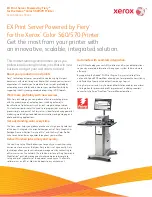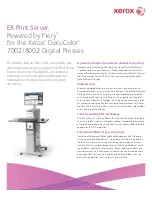
Issue 2.0
SV9100 Networking Manual
5-17
To enable this type of queuing it is necessary to:
a
Configure the VoIP equipment to mark its packets with a specific value so that the
switches/routers can identify that it is voice – Called
Marking
.
b
Configure the network equipment to recognize the difference between the
different Marked packets – Called
Classification.
(i.e., informs the router what a
voice packet looks like.
c
Configure the network equipment to give priority to the packets that have been
classified as voice – Called
Priority Queuing
.
7.2 Layer 2 QoS (802.1pq)
QoS is most commonly implemented at Layer 3 of the OSI model. This layer deals
with IP addresses, and is usually handled by Routers. However, sometimes it is
necessary to implement Layer 2 QoS – usually in large LAN environments with
many IP phones.
Layer 2 devices work with Ethernet frames (encapsulated IP packets) rather than
IP addresses. These devices are usually Switched Hubs (Switches). As the IP
header information is encapsulated, the Switched Hubs cannot reference the
Type of Service (
Layer 3 QoS
) field in the IP header to determine the priority of a
frame.
Layer 2 QoS uses the Priority field of the Ethernet frame. This field has three bits
and can have eight possible values (000 to 111 in binary). Some switches can be
configured to prioritize traffic based on these values. This field is available only if
the Ethernet device is configured for VLAN (IEEE 802.1q) operation (VLAN is
outside the scope of this document).
Summary of Contents for Univerge SV9100
Page 1: ...Networking Manual A50 035910 004 AU Issue 2 0...
Page 20: ...xviii Table of Contents Issue 2 0...
Page 26: ...xxiv List of Figures Issue 2 0...
Page 33: ...Book 1 SV9100 K CCIS...
Page 49: ...Issue 2 0 1 16 General Information US Only Figure 1 15 Circuit Identification Codes CIC...
Page 53: ...Issue 2 0 1 20 General Information US Only...
Page 61: ...Issue 2 0 2 8 Hardware Installation US Only...
Page 195: ...Issue 2 0 4 116 Features and Specifications...
Page 242: ...Book 2 SV9100 IP Networking...
Page 256: ...Issue 2 0 2 12 IP Networking...
Page 312: ...Issue 2 0 4 48 Programming...
Page 376: ...Issue 2 0 6 30 SIP Trunking...
Page 391: ...Issue 2 0 7 14 H 323 Trunking...
Page 467: ...Issue 2 0 8 76 IP Multiline Station SIP...
Page 551: ...Issue 2 0 10 64 SV9100 NetLink Conditions None Feature Cross Reference None...
Page 567: ...Issue 2 0 10 80 SV9100 NetLink Conditions None Feature Cross Reference None...
Page 579: ...Issue 2 0 11 6 NAPT...
Page 580: ...Issue 2 0 SV9100 Networking Manual 11 7...
Page 581: ...Issue 2 0 11 8 NAPT...
Page 582: ...Issue 2 0 SV9100 Networking Manual 11 9...
Page 583: ...Issue 2 0 11 10 NAPT...
Page 584: ...Issue 2 0 SV9100 Networking Manual 11 11...
Page 595: ...Issue 2 0 12 4 All DSP Busy Indication...
Page 671: ...Issue 2 0 13 76 AspireNet Conditions None Feature Cross Reference None...
Page 685: ...Issue 2 0 13 90 AspireNet Department Calling Flexible System Numbering Intercom...
Page 707: ...Issue 2 0 13 112 AspireNet Default Trunk Port Number Name 1 Line 001 2 Line 002 400 Line 400...
Page 713: ...Issue 2 0 13 118 AspireNet Department Calling...
Page 765: ...Issue 2 0 13 170 AspireNet...
















































